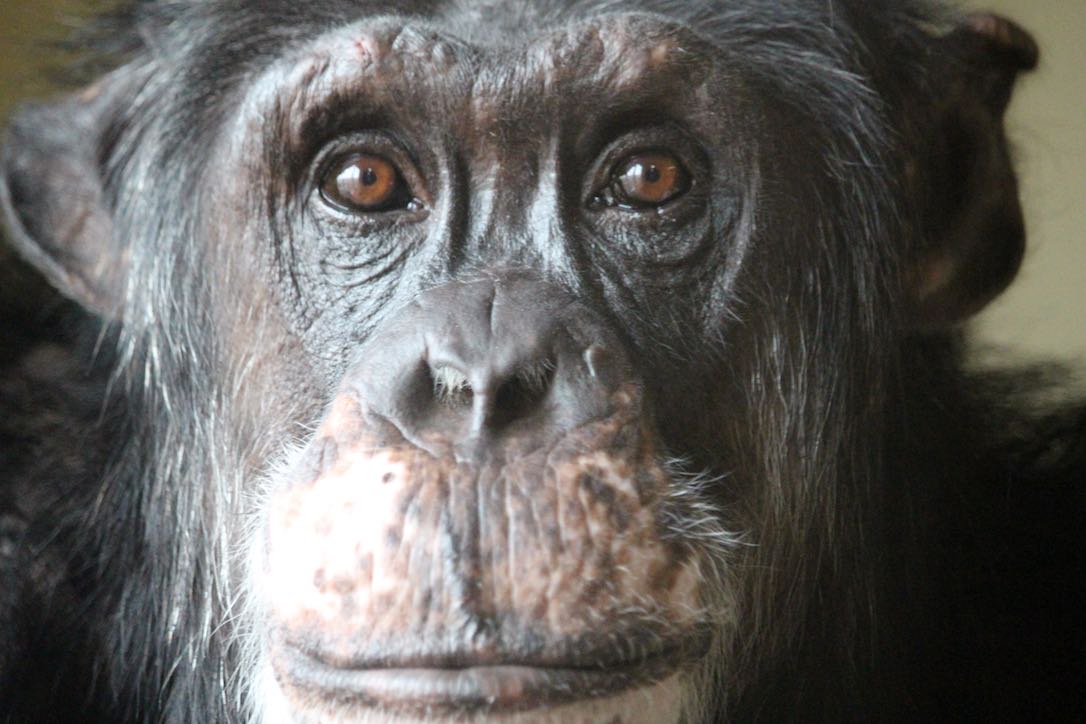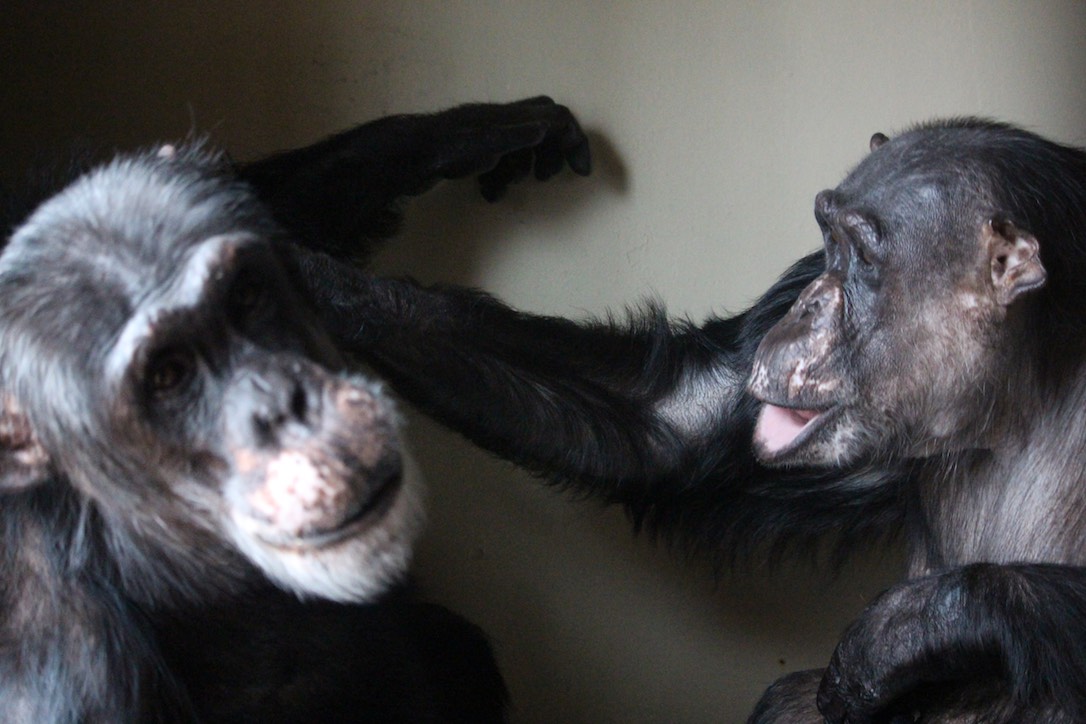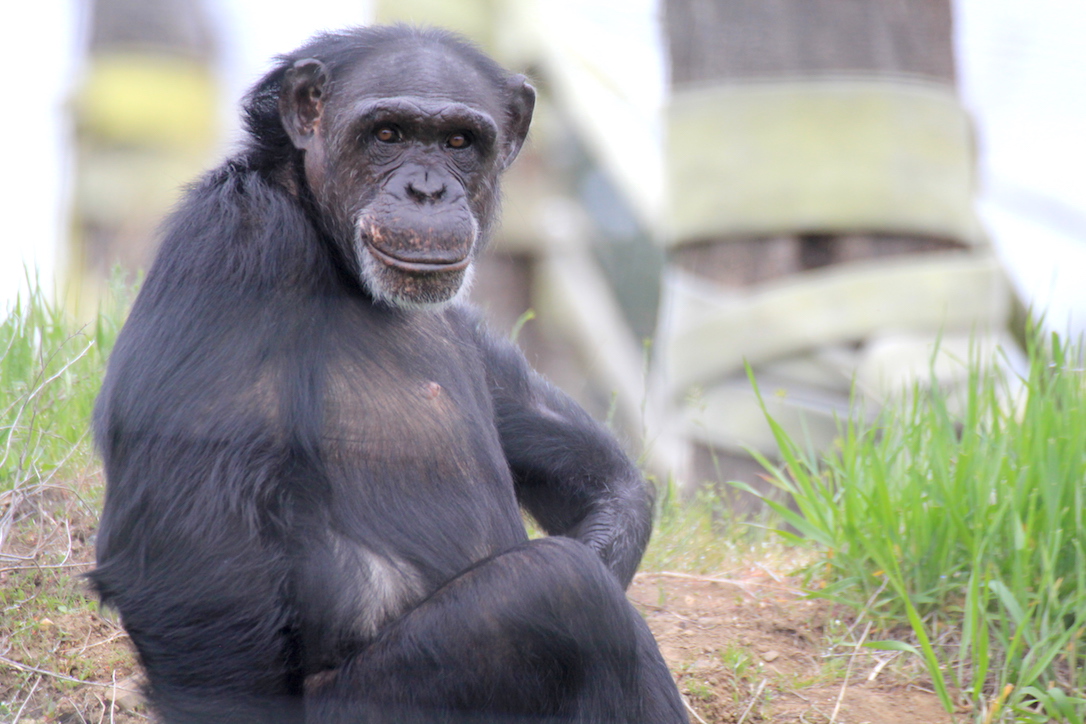
Today is the first #WorldChimpanzeeDay, a day to celebrate our closest living evolutionary cousins and an opportunity to raise awareness about the vital need for worldwide participation in their care, protection, and conservation in the wild and in the captivity.
So, in addition to celebrating the seven chimpanzees at CSNW, as we do everyday, I would like to share my personal evolution of knowledge and understanding about chimpanzees in captivity. For as long as I can remember, I’ve been fascinated by and drawn to all of the great apes. In college, I had a shrine of sorts on my wall with photos of gorillas, orangutans, and chimpanzees. One of the photos I had was a postcard of a chimpanzee who was probably four years old, wearing clothing and balancing on a tightrope. I thought it was adorable.
A few years later, I pursued my interest in great apes and ended up at Central Washington University’s Chimpanzee and Human Communication Institute. The head of the program, Dr. Roger Fouts, had recently published a book called Next of Kin, which expanded my view of chimpanzees and, for the first time, made me really think about the plight of chimpanzees in captivity and my own unquestioning amusement and delight when I saw photos of chimpanzees dressed in clothing or performing in some way.
Sitting face to face with a chimpanzee (with a safe barrier in between) was an even more powerful and humbling experience. It was immediately evident that chimpanzees have a keen sense of autonomy. They are incredibly smart and social and they have their own interests and desires.
Then I began to learn more about who they were as a species and came to the conclusion that literally no captive situation can provide chimpanzees with the socially and emotionally rich environment they would experience in the wild in Africa. The only reason there are so many chimpanzees in captivity now is because humans desired to put them there. No chimpanzee has ever volunteered to be torn from their family and forced to serve whatever purpose humans had in mind.
I share this personal experience of my own rather slow revelations because I understand both what draws people in when they see images of baby chimpanzees and how a little bit of knowledge can transform that initial “awww” reaction into a series of questions that includes: “Where is that chimpanzee’s mother?”, Where is the chimp living? (sanctuary, zoo, in the wild, in a human home)”, and “Is she or he doing something on command for the camera?”.
Sometimes it’s not possible to get immediate answers to these questions, and I’ve learned it’s important not to assume that a news organization or someone posting on social media is providing accurate information.
That brings me to a video of a young chimpanzee supposedly being reunited with a human couple that he had known as an infant. This video went viral last week and was shared on numerous national television news channels and/or their corresponding online sites, including Anderson Cooper and the Today Show, as well as dozens of local stations. I get it. The video is heartwarming and makes you want to share this “feel good” moment. But when you start to ask those questions about this video, you’ll quickly see that the chimpanzee, Limbani, was not “rescued” as those sharing the video claim. He is not living in a sanctuary, he is not living with other chimpanzees, and we don’t know where his mother is (we’ve asked). He’s living with humans 24/7 who put clothing on him and make money by having people pay to have their photo taken with him.
Limbani is living at the Zoological Wildlife Foundation (ZWF), a name that might make you think it’s a nonprofit organization with laudable aspirations. This is far from the truth. They confirmed with us that they are a for-profit business. Anyone can pay $200 to spend two minutes in a hands-on encounter with Limbani. For $700 people can spend ten minutes with this baby chimpanzee. Limbani is one of many exotic animals they have available for these “pay to play” encounters – they have the price schedule and the animals laid out very clearly on their website. Most of the animals are babies, of course, which means they are breeding more and more exotic animals into a lifetime of captivity. This is very similar to an organization called The Institute for Greatly Endangered and Rare Species (TIGERS). You’ve probably seen their videos and photos of an orangutan with a dog and a baby chimpanzee with a baby white tiger.
ZWF claims that their desire is to educate the public and help conserve endangered species. They even take donations directly from their website, which is confusing because they are not themselves a nonprofit. As a nonprofit, Chimpanzee Sanctuary Northwest is a public organization, our financial records must be publicly available, and we are obligated to spend funds towards our mission. If we are not following the rules or if a donor feels we’ve misused their money, they can appeal to the government to investigate. We are also accredited by the Global Federation of Animal Sanctuaries. The money that is given to ZWF can be spent however they like and there is no transparency or oversight required.
It’s up to everyone to speak out about this. Just like individual views like my own, societal views on animals are evolving. Most people in the US no longer find it acceptable that whales and dolphins are kept in aquariums where they perform for crowds of people (did you know it’s also World Orca Day!). The Ringling Brothers stopped using elephants in their circuses because the public became educated about the sad lives the elephants in traveling shows led. It’s beyond time for chimpanzees like Limbani to be given the same consideration.
You can spread the word whenever you see videos and photos of chimpanzees. First, ask some questions and try to get the facts of how the chimpanzee is living. Then share the facts with anyone passing along the exploitative images, including the media outlets and your friends and family.
Read about roadside zoos on our website to learn how to spot these pseudo-sanctuaries that are attempting to pose as conservation organizations or actual sanctuaries.
The North American Primate Sanctuary Alliance put out an excellent letter about this latest video of Limbani (it’s not the first video of Limbani that’s gone viral), which you can read and download here on the NAPSA website. The Dodo also published a story about the video this morning. You might want to use the hashtag #whereslimbanismom when posting about this video. We asked ZWF on instragram repeatedly about his mom and they only responded by saying that she lived in a “private sanctuary.”
Please educate others and share information in a polite way – you just never know who will be ready to have their heart opened, and opening hearts leads to changing minds.
Burrito, who was raised a pet for a year, then spent two years with a trainer before being sold into biomedical research, thanks you.









